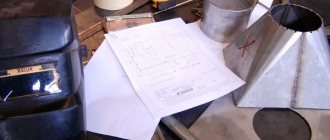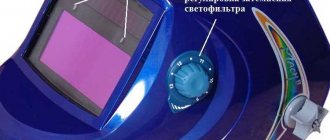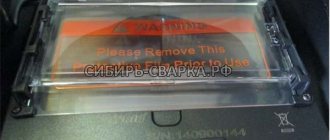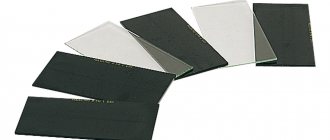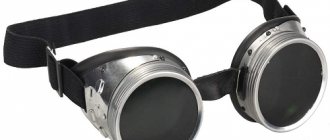Home / Accessories and parts
Back
Reading time: 3 min
0
7247
Welding work is a high-risk task, so a person must provide himself with reliable protection so as not to get hurt during work.
Very often a person suffers from sparks when working with metal, different types of radiation, gases and vapors are released during the welding process, different types of radiation...
The Chameleon welding mask is your first assistant in protecting against unpleasant consequences during work.
- Features when working with a chameleon welding helmet
- How to fix it yourself
- How to use a welding mask
- How to serve
- Conclusion
The light filter on the chameleon welding helmet does not work
We are not talking about complex repairs, but just about replacing the batteries in the “Chameleon” welding helmet.
It is a faulty power supply that causes failure in most cases. The main element of protection in the chameleon mask is an automatic light filter. It changes automatically as soon as the arc appears, allowing you to control the start of welding without blinding your eyes. As a rule, a light filter has a multilayer structure. The use of several liquid crystal layers makes it possible to reduce the dependence of dimming on the angle of incidence of light. When the arc is ignited, the crystals are arranged in a certain order, due to which part of the light flux is blocked.
For proper operation of the filter, a power source is required. For some models, these are two AAA batteries located in a special compartment on the filter housing. For other models, the power source is hidden inside the case. As a rule, these are one or two lithium elements with a voltage of 3 volts, which have a very long resource. Although it is logical to assume that a cheap mask has a cheap battery installed.
I use a Resanta welding helmet, although the model doesn't really matter. Light filters of all models have the same operating principle and differ only in the design, the element base used and the presence or absence of adjustments. Like many, I do not use welding every day, but only when necessary. And once again, getting ready to weld something there, I was disappointed to discover that the Chameleon welding helmet did not work.
When pointing at a light source, the filter did not darken or only worked once in a while. Be it the sun, a bright lamp or a lighter.
Sometimes, when I lightly tapped the mask, the light filter would work. This suggested that there was a bad contact somewhere, a loose connection or something similar. But first of all, I thought that the problem was in the power supply of the light filter. My battery is almost done.
In such cases, it is sometimes advised to expose the mask to the sun for about two hours so that the battery is recharged from the built-in LED panel.
Perhaps this is true. But I didn’t want to wait two hours every time. Moreover, it is unknown what the final result will be. Maybe it will work, maybe not. In short, I decided to figure out what exactly was going on there and, if possible, restore the filter’s functionality.
The light filter is attached to the mask using two screws. After unscrewing the screws, remove it. There is a narrow gap along the perimeter of the case. Carefully pushing the halves of the body apart, we divide it into two parts. It doesn’t matter how you do it. Inside the case there is an electronic filling of the light filter and a lithium power source. The first thing you need to do is measure the voltage on it. The nominal voltage is 3 volts, but the light filter works properly when the voltage drops to 2.5 volts. However, this is just an assumption; there may be a spread in one direction or another. In my case, the voltage at the battery terminals was just over two volts, but nothing worked.
Having made sure that the battery is “dead”, we proceed to replacement. My filter used a CR2450 element. It is sealed into the board on both sides. We very carefully unsolder it and replace it with exactly the same new one.
If you don’t find the CR2450, you can replace it with the CR2032 element for a while; it is installed on computer motherboards. It is best to use the battery with a holder, this makes it easier to replace and you don’t have to overheat the “tablet” when soldering. As a last resort, you can solder two pins. Very quickly and with good flux, to perform the operation with one easy movement of the hand.
In this case, you can use double-sided adhesive tape to secure the battery.
How to use
The rules for using the chameleon mask are indicated in the instructions supplied with it.
Before starting work with a new mask, remove the film from the protective plate . For used ones, check for visible damage.
Check the functionality of the light filters using one of the methods indicated in the section of this article “How to check without welding.”
Adjust the parameters specified in the “Types of adjustments” section of the article. The settings must be appropriate for the nature of the work being performed.
Welding work must be carried out at temperatures from 15°C to 55°C.
The use of the mask in plasma and gas welding is limited.
It is not recommended to leave the mask shield on heated surfaces.
Strong blows to the shield are contraindicated.
You cannot use spare parts for repairs that are not specified in the user manual.
If the mask does not perform the basic functions of darkening the screen, you should stop welding and look for the cause of the malfunction.
Avoid getting moisture on the filter. This may disable it.
The use of chemical detergents and solvents for cleaning is prohibited . It is recommended to wipe the filter elements with a soft, clean, lint-free cloth.
When the red light on the filter turns on, you need to replace the batteries . Replace it after switching to open screen mode.
The protection plate should be changed regularly. Droplets from molten metal cause pitting, cracks, and ultimately clouding of the screen.
Replacing batteries in the Chameleon mask
Unfortunately, the CR2032 battery did not last long.
Despite the fact that current consumption is measured in microamps, after some time the filter did not work again. Of course, a question like “What should I do?” didn't even arise. It was necessary to install a more powerful power source. The most suitable option is two 1.5V elements of size AA or AAA. They can be placed in a special battery compartment, which is commercially available. I didn’t have one, so I had to saw off the battery compartment from my favorite TV remote control.
I sawed off the part where the contacts for the batteries are located from the printed circuit board. I cleaned everything unnecessary (microcircuit and wiring) and soldered two stranded wires to the contacts. The end was lightly covered with what was at hand. It turned out to be a good battery compartment for two AA elements.
The battery compartment is attached to the mask with two M2.5 bolts. The holes are drilled in the center, so the mount does not interfere with the installation of batteries in the compartment. Can be mounted anywhere. The wires should be as short as possible. I secured the compartment at the top, above my head. In this case, the overall balancing is not disturbed, and there is free access to the compartment for replacing batteries. During idle periods, you can even remove one battery from the compartment. For the purpose of, so to speak, global economy.
Work order, necessary tools
If the light filter of the chameleon mask does not work, it completely eliminates its protective functions. There are two options left: throw the mask in a landfill or try to repair it. Self-repair can be carried out by familiarizing yourself with the procedure for performing the work and the tools used and materials from the video.
The most common reason for the lack of dimming is the failure of the power supply . The author immediately determined that his round factory battery had run out. Still, it is better to make sure that there is no voltage on the contacts using, for example, a multimeter.
Problems with the Chameleon mask
There is the following problem: when argon arc welding at 60...80A of steel strips, previously cleaned with an angle grinder, the Korund ASF 4/9-13 mask turns off for a tenth of a second. This happens rarely and most often when passing seams inside corners. Nevertheless, I manage to catch the “rabbits”, then, naturally, my eyes turn red and pain appears. Question: is the problem with the mask or is it my “crooked little hands” that are to blame?
Naturally, it is impossible to give a definite answer to this question. But there are several recommendations, because Chinese chameleon masks have been sold for several days and a lot of experience has been accumulated in their use. Take more interest from fellow welders.
Read the article on the website: Repairing a chameleon mask with your own hands
- Option number one: the optical sensor “does not see” the arc when welding in hard-to-reach places (or you cover the photocell with your hand). Adjust the sensitivity using the tuning knob. If it doesn't help, try using a regular filter. If you don’t want to burden yourself with selecting a light filter when welding at low/high currents, look for a mask with an electromagnetic arc sensor. Even such good PPE as Speedglas opens if you cook it “around the corner.”
- Option number two: the dimming is very slow, set the adjustment knob to maximum.
- The problem may also be this: simple cheap masks behave quite correctly when working with conventional inverters (without a set of “cool” welding functions). But as soon as you switch to professional equipment with the function of smooth ignition and arc extinction at a predetermined time, problems begin to appear. When ignited, the mask works normally, but after a while, when the arc flares up more strongly, subsecond shutdowns occur. This can be explained this way: the electronics adjust to the brightness of the light flux once, and then, when its intensity increases, it does not work a second time, because it is not adapted to such changes.
Add a comment Cancel reply
You must be logged in to post a comment.
Is it worth BUYING, reviews from welders:
- Welding transformer PATRIOT 200AC 102.00 RUR
- Charger GreenWorks G24C RUB 2,490.00
- Voltage stabilizer PRORAB DVR 1000 2597.22 RUR
- Stabilizer Resanta ASN-2000 N/1-C Lux 3610.00 ₽
- Voltage stabilizer Stavr SN-2000 3920.00 RUR
- Welding machine BauMaster AW-79161 3990.00 RUR
- Hitachi AB17 charger RUB 4,076.87
How to adjust the mask, auto darkening degree
The author of the following video, a practicing welder and at the same time a talented teacher, shows in an accessible form how to adjust the parameters of the chameleon mask. An inexpensive Chinese-made mask is used as a sample.
A specific example shows how to choose the optimal darkening. It is emphasized that with proper adjustment, a small area of the heat-affected zone should be visible. The advantage of the video is that it contains a table of correspondence between the dimming parameters and the current strength of the welding operation being performed. The values in the table are recommended; the author draws attention to the effect of dimming the vision of the welder on the setting.
Briefly, but very clearly, the process of selecting the delay time for opening the screen window after welding is described.
Setting the sensitivity or response threshold of a light filter causes difficulties for novice welders, because depends on external conditions. The author clearly explained why, due to incorrect sensitivity settings, you can “catch a bunny” (see the arc not through a darkened screen). The author's fundamental rule for adjusting sensitivity
A small drawback of the video is the lack of description of how to adjust the mask for convenient fixation on the welder’s head. Perhaps the author wanted to leave more time for summing up the results of the competition.
How to set up a Chameleon mask for welding
Like all other welding helmets, the Chameleon protects the welder's eyes from infrared radiation. The automatically adjustable light filter operates in a convenient mode: the screen changes the degree of darkness depending on the illumination of the working field. When the Chameleon welding helmet does not darken, it is dangerous to work.
You need to figure out why the screen is not working. Sometimes it is enough to change the power supply elements and charge the battery. A dirty screen reacts worse to light; it may need to be wiped. If this does not help, it is better to turn to professionals.
How to configure correctly, what do you need to remember?
After purchasing a new device, you must study the operating instructions . This will help you figure out how to set up a chameleon mask for welding. Types of adjustments will be discussed later. Now we will give some useful tips to future users:
- Do not use the chameleon for gas or plasma welding or cutting.
- The mask has temperature protection against short-term exposures. If you leave the mask on a hot surface for a long time, it may become unusable.
- The body of the shield is not designed for intense mechanical impact. A strong blow can break it.
- Unauthorized changes to the design of the light filter are not allowed. Disassembling the cartridge yourself may cause damage. When replacing components, use spare parts recommended by the manufacturer.
- Do not use surfactants or solvents to clean the mask. Water getting on the filter is strictly unacceptable.
- Replace power supplies only in grinding mode. Salt batteries are used as removable batteries.
- Immediately after purchase, adjust all available settings to your preferences. Even incorrect adjustment of the fastening straps will result in skin irritation.
Adjusting the Chameleon welding helmet
To understand how the Chameleon welding helmet works, you need to know the basic structural elements of the protective device. The overview screen has a layered structure:
- fireproof glass that does not transmit ultraviolet and infrared radiation;
- layers of polymer crystals that change transmission capacity;
- In order for the filters to darken, they are connected to a current source;
- light sensors (from 2 to 4, depending on the model);
- connection diagram to the power supply.
At the moment of welding, a spark appears, then a luminous flux. The radiation triggers the sensors, the crystals are polarized, and the screen darkens. The welder sees the junction of metals within the range acceptable to the eye. After turning off the light source (electrode or arc), the sensors are triggered again. The screen brightens.
The tuning system regulates:
- the degree of screen darkening, it is selected according to the instructions, depending on the type of welding;
- sensitivity to changes in light flux;
- shutter speed, that is, the time period for turning off the light protection.
The adjustment is made at the preparatory stage, when the serviceability of the Chameleon mask is checked before work.
How to properly prepare a welding helmet for work is written in the operating instructions. Setting up a chameleon mask includes several steps:
- a convenient distance from the face to the protective screen is set, this is done by loosening the clamps;
- The position of the filter is adjusted, the comfort of viewing the working area depends on this;
- the intensity regulator is installed: it is determined in what mode the Chameleon welding mask is used, the operating instructions must contain adjustment tables;
- depending on the current strength of the welding machine and the illumination of the workplace, the sensitivity mode is selected; high is indicated by the letter “H”, low – “L”, minimum – “L0”, it is selected experimentally, it is easy to adjust the Chameleon welder masks during work;
- the holding time depends on the type of welding; for spot welding, a minimum interval is enough; for electrode welding, when a melt pool is formed, it is necessary for the screen to remain darkened longer.
Principle of operation
The appearance of the mask is not very different from classic models. The design is as follows:
- A housing that protects the welder from splashes of molten metal and other harmful factors.
- Liquid crystal multilayer light filter with the function of automatic adjustment of the darkening level, depending on the intensity of work.
- Module for setting and controlling the light filter.
- Removable power supply.
A light filter is installed in the viewing glass. It is a device with several liquid crystals. In an inactive state, they do not show themselves in any way - the glass only protects from glare. But when the light sensors signal, the filter comes into operation, rearranging the arrangement of the crystals, darkening the glass. The reaction to the flash is almost instantaneous - about 0.0005 seconds.
The filter also reacts to the end of work with a delay, the level of which is set manually.
Please note that the design, thanks to built-in filters, provides protection from infrared and ultraviolet radiation even if it breaks.
Possible malfunctions and methods for eliminating them
- The screen will not respond to light unless connected to a power supply. If the model is equipped with AAA alkaloid batteries or rechargeable batteries, charging indicators are displayed in the screen area. If the red light is on, it's time to replace the batteries. Solar panels are charged while welding. If the mask does not turn on, point it towards a light source for a few minutes.
- If the screen darkens unevenly, check the distance from it to both eyes. Perhaps while they were adjusting the mask and adjusting it to the head, the filter shifted. It should be parallel to the face. Loosen the clamps and align the casing.
- If the screen flickers during welding, it may be due to the outer glass. Sometimes it is enough to wash it. In case of mechanical damage (scratches, surface chips) it must be replaced. If the filter continues to act up, check the cleanliness of the sensor surface. When there are two operating modes (welding and grinding), check which position the switch is in. The screen may flicker when low-current welding in low sensitivity mode. The desired level can be established experimentally during operation.
- The filter does not darken immediately in the cold. Viewing screens quickly change the degree of darkness in the temperature range from +50 to -10°C; Chameleons are not intended for harsh winters.
- If the weld seam is difficult to see, there may be several reasons. Sometimes the film is forgotten on the protective glass. You can try cleaning it, switching the dimming control.
How to test a Chameleon mask without welding
When you hold down the Test button for five seconds, the filter should darken. If there is no such configuration function, you need to check Chameleon in other ways. The sensors are triggered by a powerful light beam. The filter is turned towards the light source at least three times, the screen should darken in all cases. Light protection reacts to:
- radiation from the sun (the filter should darken and open after an exposure interval, because the flow is of constant intensity);
- red spirals of incandescent lamps (darkening persists throughout the entire period of being near the emitter; it operates at an alternating current frequency);
- a spark from a silicon lighter (the filter darkens sporadically when the wheel knocks out a spark);
- remote control for household appliances (sensors react to infrared radiation pulses, the light output of the remote control is uniform);
- smartphone screen during flash.
If the filter does not respond, check the power supply: change the batteries or batteries, charge the solar panels. The sensitivity of the filter is checked with an incandescent lamp. If the spiral is equally visible at different settings, the regulator does not work.
Carrying out maintenance
Welders should inspect the Chameleon at least once a month. Dirt is removed with a soft rag or cotton cloth. Cleaning products with aggressive, oily and abrasive bases are not suitable for glass. It is important to remember that filters are fragile and cannot withstand shock loads. To get to the light sensors, the casing is dismantled. This is done when the power supply is turned off, just remove the batteries.
Step-by-step instructions for replacing the protective screen:
- The cartridge latches are moved to the center of the filter and opened.
- The damaged glass is removed along with the rubber gasket, and it is replaced with a new light filter of the Chameleon mask.
- The assembled cartridge is installed in its working position. It should fit tightly.
When replacing the filter, remove the regulator knob and potentiometer. Then the elements are assembled in the reverse order. Be sure to check the sensitivity lever; the delay time adjustment should work perfectly so as not to catch “bunnies”.
Types of adjustments
The following basic parameters are subject to adjustment of the chameleon mask.
Adjusting the position of the mask on the head. Reliable fixation of the mask on the head is carried out using a handle located at the back of the head and a belt passing through the top of the head.
Selecting the optimal distance from the eyes to the filter. There are latches on the mask, by loosening which you can move the filter closer or further to the eyes . After choosing the optimal distance, you should not forget about securing the clamps.
Select the dimming level. By rotating the wheel located outside the mask, the darkening mode is selected . The scale indicates levels from 0 to 16 according to the European DIN standard , where the sixteenth will have the maximum darkness. Despite the existence of all kinds of tables, each welder approaches the choice of darkening intensity in his own way, as well as the choice of the electrode and welding current.
Adjusting sensitivity. This adjustment allows you to select the optimal filter threshold . During the welding process, you can rotate the wheel to select the on/off mode, not only taking into account the intensity of the welding arc radiation. The sensitivity of the filter is influenced by the radiation of the molten metal, glare from the welding of a neighbor - a welder, and other light sources.
Adjustment of delay time. Welding technologies leave behind seams with varying degrees of cooling rates. After welding with a high current, the deposited mass will cool for a long time, and a short weld made at a low current will cool very quickly. The opening of the filter in the first case will be with a greater time delay, in the second it will open almost immediately.
Safety precautions
Before putting it on, check the settings, operating mode switches, and battery charge. Always check to see if the filter is getting dark. If it turns off during welding, the protective glass protects the eye to a small extent from IR and UV rays. But it’s safer to stop working immediately. It is dangerous to use a faulty mask. If a defect is found or the filter does not respond, the malfunction is serious and welding cannot be continued.
It must be remembered when working that the powerful radiation of the arc and molten electrodes is destructive. In addition to discomfort, this threatens to damage the retina. To prevent loss of vision, it is necessary to correctly adjust the degree of darkening of the filter.
To preserve the mask, it is important to follow the storage regime: non-functioning filters and solar panels protect from exposure to light.
